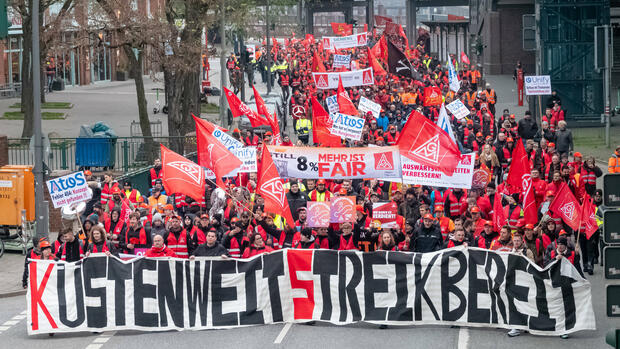In the past year, wage disputes in the metal and electrical industry were among the most contentious.
(Photo: IMAGO/Nikito)
Berlin Strikes at airports, in garbage collection, in day care centers or on the railways: This year the unions have already flexed their muscles. “Against the background of historically high inflation rates, the distribution conflict has intensified significantly,” says Thorsten Schulten, head of the WSI collective bargaining archive of the trade union-affiliated Hans Böckler Foundation.
Hagen Lesch from the German Economic Institute (IW) also analyzes that the climate in collective bargaining disputes has become significantly rougher in the first quarter of this year. But in the longer term, Germany is only in the lower midfield when it comes to labor disputes in an international comparison. This also applies to the past year, as the new WSI labor dispute balance sheet shows.
According to the Düsseldorf researchers, a total of 225 labor disputes took place last year, involving a total of 930,000 strikers. Smaller disputes at the level of individual companies, which involve in-house collective agreements or even entry into collective bargaining, are taken into account, as are large-scale strikes in the metal and electrical industries that attract public attention.
Mathematically, 674,000 working days were lost as a result of the work stoppages last year, which is just above the long-term average for the years 2006 to 2022. For example, the number was significantly higher in 2018 with almost 1.2 million and 2025 with more than two million lost days.
In addition to the metal and electrical industry, there were larger area strikes last year in the social and educational services, at the seaports or at the university hospitals in North Rhine-Westphalia.
>> Read here: Why the railway wage conflict is stuck – and new strikes are imminent
In other countries, the trade unions are much more willing to go on strike than in Germany, but this is also due to a different strike culture. For example, strikes for political reasons, such as those against the pension reform in France, are not permitted in this country.
In Germany, between 2012 and 2021, an annual average of 18 working days per 1000 employees were lost due to strikes. Belgium was the leader in the period under review with 96 lost days, followed by France with 92 days, with data only available up to 2020.
The conflict intensity of labor disputes has increased significantly this year.
(Photo: ddp/Sulupress)
Canada, Denmark, Finland, Spain, Norway and the Netherlands are also still ahead of Germany in terms of the intensity of industrial action, but the Netherlands is only slightly more with 22 lost days.
For the first time, the WSI has also determined on the basis of its labor force survey what proportion of employees in Germany have experienced a strike. According to this, around one in six employees (17 percent) has already taken part in labor disputes. Among union members, the proportion is significantly higher at 49 percent than among unorganized employees (11 percent).
In addition to the WSI, the IW also regularly examines the conflict intensity of wage disputes in Germany. It has developed its own indicator for this. These include, for example, criteria such as threats of strikes, break-offs in negotiations, warning strikes, arbitration or ballots on indefinite strikes.
IW researcher Lesch determined an average indicator value of 8.9 points for eleven wage disputes examined in the first quarter of this year. This exceeded the previous year’s figure by a factor of 1.7. The wage round in the public sector was the most controversial in the first three months, followed by the paper processing industry and Deutsche Post.
The average conflict intensity for the years 2010 to 2022 is 8.5 points, and wage disputes have escalated less than in the first three months of this year. “The fact that the negotiations in the first quarter were more conflictive has to do with the ever-increasing wage demands, which in turn are a reaction to the persistent inflation,” writes IW researcher Lesch in his analysis.
More: agreement in the collective bargaining dispute in the public sector
